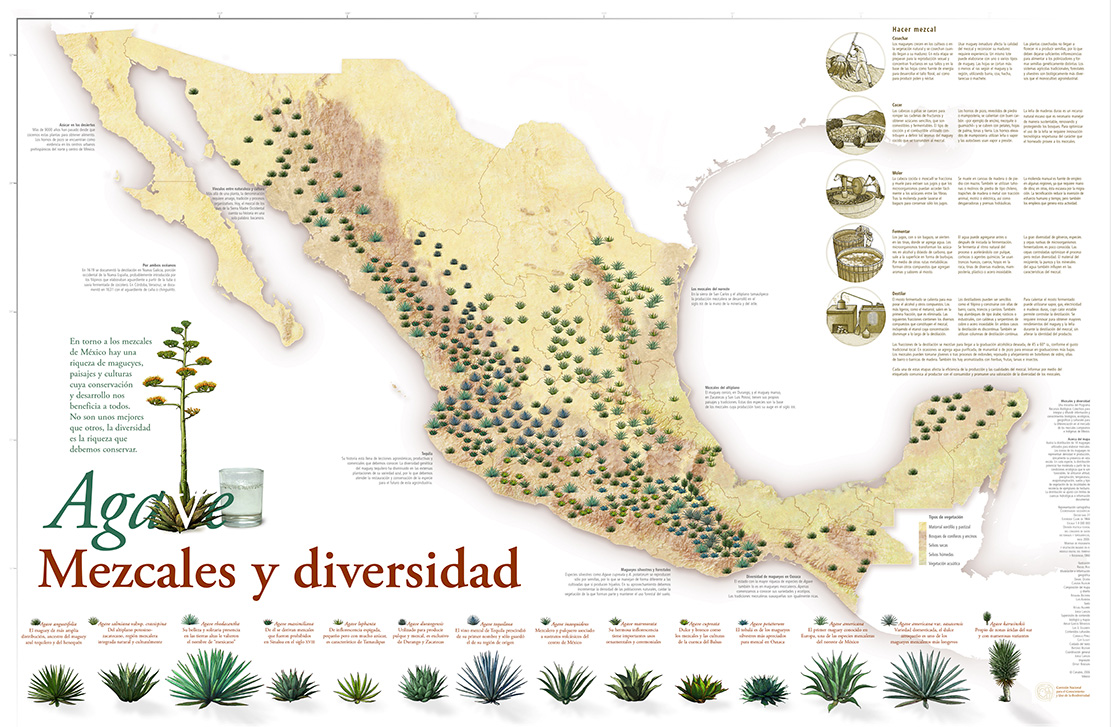TYPES OF AGAVES
AGAVE 101


AGAVE ANGUSTIFOLIA HAW
From Latin: angus, meaning narrow in reference to the shape of its pencas (leaves)
Common name: Espadín in Spanish which means “little sword”, also a reference to its pencas.
Details: Its colour can range from light green to blueish grey.
It is by far the most common variety used to make mezcal (over 80% of mezcal is made from maguey espadín). This is because it can be found all over Mexico, can adapt to mostly any climate, is easy to cultivate, and has a high concentration of sugars (similar to the blue agave variety used in tequila production).
While there are many subspecies or varieties, many are yet to be scientifically described.
Experiment with agave angustifolia from several regions and you will note the difference in aromas and flavours!
Years to maturity: 7-9

Agave tequilana Weber var. azul
Common names: Blue agave
Details: A close relative to espadín with blueish-grey leaves. The agave that changed it all after it became the only agave permitted for the production of tequila. A resilient species with a high sugar content and many different terpenes resulting in a sweet and floral mezcal/tequila.
Years to maturity: 7-9

Agave rhodacantha Trel.
Common name: Maguey mexicano
Details: Very similar in appearance and distribution as agave angustifolia. Can be differentiated by its larger rosette and by having more leaves. A very important agave for mezcal production throughout Mexico and aromas and flavours will vary throughout the mezcal regions.
Years to maturity: 8-11

Agave durangensis Gentry
From Latin: from Durango
Common name: Maguey cenizo due to its often ashen tone of colour.
Details: Cenizo is the most important agave mezcalero to the northern state of Durango, one of the states with the greatest diversity of agaves and production output after Oaxaca. Wild, they grow amongst other native plants such as the nopal cactus and sotoles (Dasylirion).
Cenizos have a medium to large rosette, containing 40-90 pencas and ranging from 0.7-1.5m in height and 1.2-1.8m in diameter. While greener while young, most take on a more blueish grey later in life (hence the name “cenizo”).
Years to maturity: 8-15

Agave karwinskii Zucc.
Other names: Cuishe, madrecuishe, bicuishe, tripón, tobaziche, barril, cirial, largo
Details: Notable for growing vertically and of the only species to have part of its piña above ground. Endemic to Oaxaca and very south of Puebla. Among the most popular agaves in Oaxaca for mezcal production, it often adds earthy and mineral tones to the mezcal.

Agave cupreata Trel. & A. Berger
From Latin: cuprum→copper as it’s thorns are a reddish, copper colour.
Common names: Maguey chino (curly), papalote, papalotl (butterfly in Nahuatl)
Details: Medium- sized broad agave with serrated, curvy leaves and copper thorns. Endemic only to the basin of the Balsas River in southwestern Mexico. The most important agave mezcalero to the states of Michoacan and Guerrero. Grows wild in this region but is now cultivated as well for mezcal production. Known for its great flavour, this sweet yet fragrant and mature agave is always a crowd pleaser.
Years to Maturity: 8-15

Agave inaequidens
Name comes from “uneven”, describing the irregular form of the spines.
Other names: Maguey alto, maguey bruto
Details: Another agave very important to mezcal production in Michoacan. Found at a higher elevation than agave cupreata. Generally a bit darker in colour, less curvy and larger than cupreata. Contains less sugars than cupreata and thus yields much less mezcal. Often imparts herbal notes.
Years to Maturity: ~15

Agave salmiana subsp. Crassispina
Common names: Maguey verde, maguey pulquero
Details: Mostly found in the central Mexican highlands in the states of Durango, Zacatecas Coahuila and San Luis Potosí. Among the first agaves with importance to the original tribes of Mexico as it became the agave from which pulque, a fermented agave drink, was made. Today, it is the most important agave mezcalero to the central state of San Luis Potosí, with a few different subspecies being distilled. It is also the second most utilized in Durango, after cenizo. Mezcal from agave salmiana often has herbal and lactic notes, with a satisfying spicy finish.

Agave potatorum Zucc.
The scientific name comes from Latin and means drinker (of wine) since it is known as one of the most important plants used to make mezcal.
Common names: tobalá (the maguey), papalometl (butterfly in Nahuatl).
Details: This relatively small agave is found in the state of Oaxaca and Puebla. The species can be identified by its symmetrical and compact rosette that grows no higher than 50cm and no longer than 60cm in diameter. The pencas (leaves) come to a point and are greenish grey in colour with many triangular teeth.
Years to maturity: ~12
